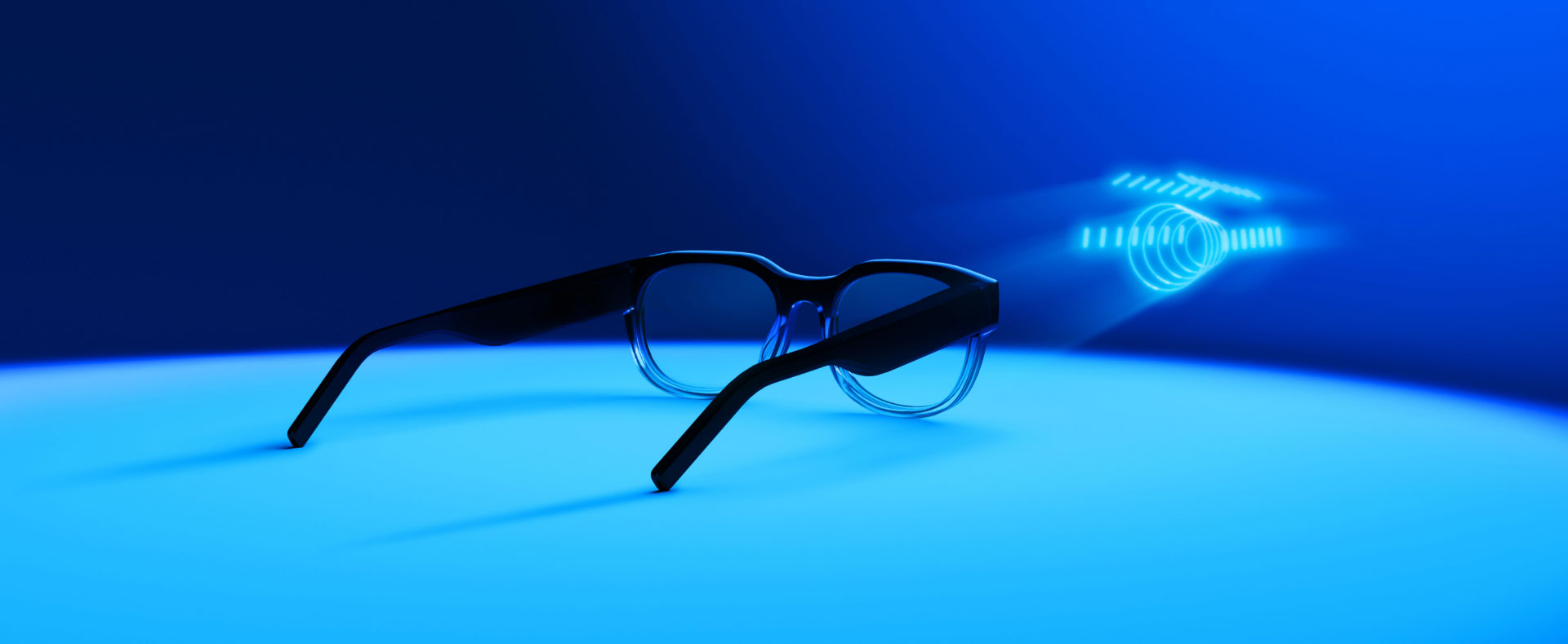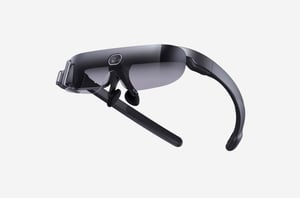In the year 2020, we saw significant progress in AR wearables. 2021 has started strong as well.
It is time to update our list of state of AR, MR, and smart glasses from last year. A lot is going on, and the future of eyewear looks bright!
Below presented all the glasses we could find - the launched, the buried, the upcoming, the rumored. First by category, and in a table at the end of this post. If you know of any AR, MR, or smart eyewear not listed here, please let us know!
AR Glasses
AntVR MIX
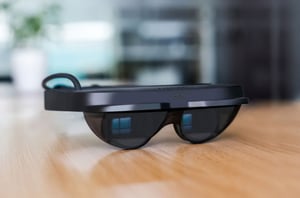 MIX: The Smallest AR Glasses with 96-degree FoV.
MIX: The Smallest AR Glasses with 96-degree FoV.
This one is a mystery: the AntVR website looks very much on business, but no information about their MIX glasses is found. When navigating to Buy now -site, the comment section hints that the company has gone silent.
The company ran through a successful Kickstarter campaign and said to have tremendous success worldwide, and is now stepping into the world of AR. Does anyone know anything about this?
Apple
 There is not much to say about the Apple Glasses yet, for there are only rumors. We know for sure that Apple has filed a patent of what seems to be a pair of AR glasses and has partnered with a micro OLED display manufacturer.
There is not much to say about the Apple Glasses yet, for there are only rumors. We know for sure that Apple has filed a patent of what seems to be a pair of AR glasses and has partnered with a micro OLED display manufacturer.
Apple has been acquiring several AR companies in the resent, which suggests Apple is working on its own AR product. Many recently-appeared Apple patents explain how specially-designed lenses could cast images on a user's eye and how a touchscreen surface could be used as a controller.
Rumors have set the launch date somewhere between mid-2021 and 2023. With not much information, we'll stand by and wait for an update.
CREAL
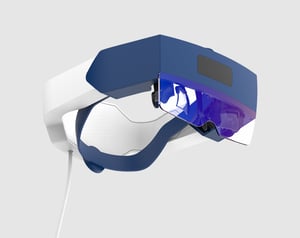 CREAL introduces itself as the possibly very first light-field augmented reality headset. The headset has continuous depth resolution and High spatial resolution, with no eye-tracking.
CREAL introduces itself as the possibly very first light-field augmented reality headset. The headset has continuous depth resolution and High spatial resolution, with no eye-tracking.
CREAL's light-field recreates light just like in the real world. It features projectors embedded in glasses' arms, multiple perspectives of one digital scene projected to each eye, and 6000 images sent every second.
CREAL Light-field promises to be a missing key to comfortable smart eyewear. CREAL offers AR technology evaluation kits, engineering and integration support, with specifications for the smart glass light-field optical engine planned for Q4 2022.
Dream Glass 4K
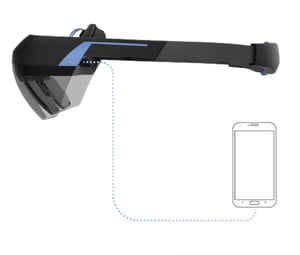 The DreamWorld's Dream Glass 4K glasses' 90-degree FOV and 2.5K resolution combine the virtual world with reality. It comes with smartphone compatibility, hand gesture recognition, and 3 degree-of-freedom head tracking.
The DreamWorld's Dream Glass 4K glasses' 90-degree FOV and 2.5K resolution combine the virtual world with reality. It comes with smartphone compatibility, hand gesture recognition, and 3 degree-of-freedom head tracking.
The Dream Glass is more targeted to the consumer market. The price is a fraction of competitors like Magic Leap and Google Glass but promises to have better-quality features.
The Dream Glass 4K launched an Indiegogo fundraising in mid-July 2020 and hit its goal in 8 minutes. The improved Dream Glass 4K Plus has all the regular 4K Version functions, but with an upgraded ram, ample storage, and an extra USB port for accessories. The user can connect recording RGB camera, hand gesture cameras, or 6DOF tracking set to it.
EyeWay Vision
EyeWay is an Israeli company developing an immersive wearable augmented reality platform. At the beginning of April 2021, the company announced that it has joined the newly formed LaSAR Alliance (Laser Scanning for Augmented Reality).
The wearable augmented reality system features high contrast in all ambient light conditions indoors and out. It also has a Field of View that follows gaze, variable focus, and human eye resolution.
The company's vision is to enable natural interaction and viewing of virtual and physical.
EyeWay hasn't yet issued any info about when and at what price range the system will be released. We'll keep our eyes on this one!
Garmin Varia Vision
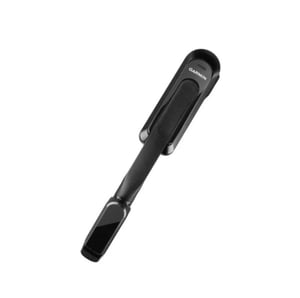 View cycling stats without taking your eyes off the road with Garmin Varia Vision.
View cycling stats without taking your eyes off the road with Garmin Varia Vision.
The first in-sight cycling display from Garmin enhances your road awareness by putting the cycling information you want right where you want it. Stay focused while trying nailing your targets for a workout, find the next turn, or stay aware of cars approaching from behind.
View information such as your heart rate, power, and speed while keeping your eyes peeled for potential hazards in front of you. Varia Vision has detailed navigation prompts with street names, directional arrows, and distance to turn.
Google Glass Enterprise Edition 2
Stay focused, improve accuracy, and collaborate in real-time. This is what Google Glass Enterprise Edition promises. Glass provides hands-on workers and professionals with glanceable, voice-activated assistance designed to be worn all day.
The Enterprise Edition device has been specially designed for enterprises, from doctors to automobile assemblers. If you're not happy with what Google has to offer, you can build your own Glasswear with Glass Explorer Edition.
Everysight Raptor
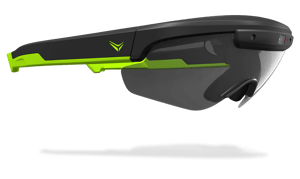 Everysight Raptor is a computer for people, not bikes. Raptor is designed to enhance cycling by projecting an AR layer of information in front of the cyclist's eyes.
Everysight Raptor is a computer for people, not bikes. Raptor is designed to enhance cycling by projecting an AR layer of information in front of the cyclist's eyes.
Raptor's patented Everysight BEAMTM projection technology provides easily accessible yet non-intrusive information. You can take HD pictures and videos with just a tap or voice command. Raptor connects to your smartphone with Bluetooth, so there is no need to pause your cycling experience for an email or change a song on your playlist.
Kura
 Kura Gallium advertises to be the widest field-of-view and lightweight AR headset for the masses.
Kura Gallium advertises to be the widest field-of-view and lightweight AR headset for the masses.
Kura's features: 150° Field of View, 8K75, 6K100 / 4K144, adjustable resolution per eye with VESA display stream compression, 95% transparent, structured geometric waveguide eyepiece, high dynamic range, true black, and 100% DCI-P3 coverage with up to 10-bit color via LED technology, 4000-nit equivalent outdoors viewable image and unlimited depth of field, prescription compatible.
Kura glasses don't ship yet, but the company is taking reservations. The company will also launch Kura Alphas. They are minimal numbers of pre-production dev kits that the company will make and ship during 2021, before Kura Gallium shipping. The price tag will be around $1,500.
LeapMotion North Star
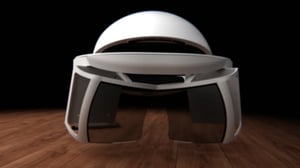 North Star is a complete augmented reality platform. It is the first step towards Leap Motion's insight into AR: the tech is not about the hardware but the experience.
North Star is a complete augmented reality platform. It is the first step towards Leap Motion's insight into AR: the tech is not about the hardware but the experience.
North Star includes two low-persistence 1600×1440 displays pushing 120 frames per second with an expansive visual field over 100 degrees. It is coupled with the company's 180° hand-tracking sensor.
Leap Motion open-sourced the headset, hoping to accelerate experimentation and discussion around what AR can be. Anyone can download the package from the company's website or dig into the project on GitHub, where it's been published under an Apache license.
LetinAR PinMR
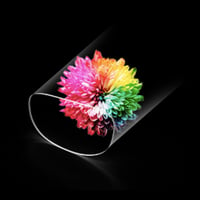 LetinAR's PinMR™ optical solutions consist of optic lenses and a micro-display. There are two types of PinMR™ optical lenses – one for eyeglasses, having a small form-factor with adequate performance, and one for goggles with higher performance.
LetinAR's PinMR™ optical solutions consist of optic lenses and a micro-display. There are two types of PinMR™ optical lenses – one for eyeglasses, having a small form-factor with adequate performance, and one for goggles with higher performance.
The PinMR glasses resolve many issues consumers and AR companies have identified, such as bulky form factors, narrow FoV, low color expression, high prices, and costly and complicated manufacturing.
Lynx
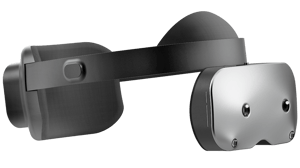 Lynx is the first AR+VR stand-alone headset.
Lynx is the first AR+VR stand-alone headset.
Lynx lens design reduces the display module's depth by half than the other HMDs in the market. It comes with Dual LCD 1600x1600@90Hz resolution, 1600x1600@90Hz, 4-fold catadioptric freeform prism optics, and 90° (circular) /18ppd FoV/PPD.
With Lynx's open sensor policy, raw data from every sensor is available to the developer, including RGB cameras, point clouds, eye tracking, and hand poses. Two built-in noise-canceling microphones for optimal communication, vocal command, and speech-to-text features. Spatial audio speakers are integrated into the headband for better immersion.
Meta 2
The Meta 2 Development Kit promises virtual workspaces of the future becoming a reality today. The high-resolution projections of Meta 2, connected with Unity 3D and SOLIDWORKS interfaces, enable the three-dimensional display of 3D and CAD models amid the real world. With intuitive hand-gesture control, the users can also interact with these holograms in real-time.
The purpose of Meta 2 is to be used in testing and development rather than for public usage. The Meta 2 is capable of real-time tracking and mapping spaces, meaning the users can lock their content in 3D space.
Mira Prism
 Mira's Prism hardware is a headset that takes advantage of the device you already have. It duplicates your mobile's screen on a see-through display - without blocking the user from the real world.
Mira's Prism hardware is a headset that takes advantage of the device you already have. It duplicates your mobile's screen on a see-through display - without blocking the user from the real world.
The Prism headset includes an intuitive hands-free and heads-up interface controlled by the user's gaze. Prism has a battery lasting up to 4 hours, an attached camera, and is compatible with iPhone 7, 8, and SE.
Niantic
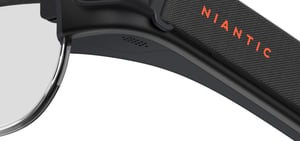 Surprisingly, in March 2021, Niantic's CEO John Hanke posted a cryptic message on Twitter. The post includes a cropped image of a pair of glasses accompanied with text: "Exciting to see the progress we're making to enable new kinds of devices that leverage our platform."
Surprisingly, in March 2021, Niantic's CEO John Hanke posted a cryptic message on Twitter. The post includes a cropped image of a pair of glasses accompanied with text: "Exciting to see the progress we're making to enable new kinds of devices that leverage our platform."
With no additional info about plausible Niantic AR glasses, we'll keep an eye on them and give an update on our next roundup!
North Focals
Focals by North were among the most awaited AR glasses until Google acquired the company in July 2020. The production of Focals was ceased, and no further info about their future is revealed.
The company states that with Google, it will continue its work to blend technology seamlessly into our world. So, nothing else to do than wait for the info of what's to come.
Oppo AR Glass
 Oppo announced its AR glasses already in 2019 and said to launch them in early 2020. However, the company's site doesn't state anything about the headset.
Oppo announced its AR glasses already in 2019 and said to launch them in early 2020. However, the company's site doesn't state anything about the headset.
Some of the uses announced for AR Glass include augmented reality content and games, workplace, and service uses. AR Glass workplace and service applications include 3D modeling and design. AR glass users can use both hand gestures and voice controls.
The glasses are said to include a TOF depth sensor and SLAM algorithm to enable 3D environment sensing and 3D reconstruction. They are combined with a full-color high-definition display that is made possible by diffractive waveguide technology.
Snap Spectacles
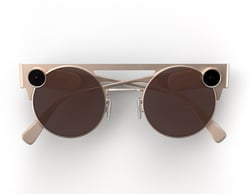 Snap's Spectacles come with several frames to choose from. The consumer-targeted glasses have two human-eye-inspired cameras to capture 3D photos and videos at 60 fps. At the same time, four built-in microphones record immersive, high-fidelity audio.
Snap's Spectacles come with several frames to choose from. The consumer-targeted glasses have two human-eye-inspired cameras to capture 3D photos and videos at 60 fps. At the same time, four built-in microphones record immersive, high-fidelity audio.
Photos and videos wirelessly sync to your smartphone, where you can edit and transform them and then share them anywhere you want. The new Spectacles 3 even allows you to explore the underwater world.
STMicroelectronics and Quanta Computer
STMicroelectronics, a global semiconductor leader serving customers across the spectrum of electronics applications, and Quanta Computer, a world-leading notebook computer manufacturer, agreed on a joint effort to develop a reference design for AR smart glasses last November.
The reference design aims to integrate and build upon the expertise of the LaSAR3 Alliance into small, lightweight, and fashionable AR glasses. The glasses would operate at low power and assure a good Field-of-View (FoV) with a large eye box.
ST and Quanta anticipated the reference design being made available to OEMs in Q1 2021.
Toshiba dynaEdge AR100 Viewer
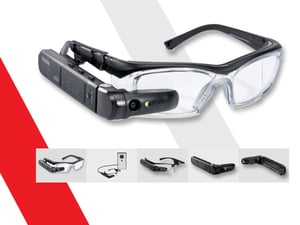 Toshiba's dynaEdge™ AR Smart Glasses is an AR solution designed to help large enterprises improve efficiency, quality, and operating flexibility. The glasses enable multiple usage scenarios, including see-what-I-see, remote expert, document retrieval, workflow instructions, and real-time data capture. The glasses use Toshiba Vision DE Suite™ software.
Toshiba's dynaEdge™ AR Smart Glasses is an AR solution designed to help large enterprises improve efficiency, quality, and operating flexibility. The glasses enable multiple usage scenarios, including see-what-I-see, remote expert, document retrieval, workflow instructions, and real-time data capture. The glasses use Toshiba Vision DE Suite™ software.
The dynaEdge AR100 offers various methods to input and navigate. It includes a touchpad and programmable buttons on the HMD and directional buttons on the waist-mounted mobile mini PC and voice and gesture capabilities.
Trivisio
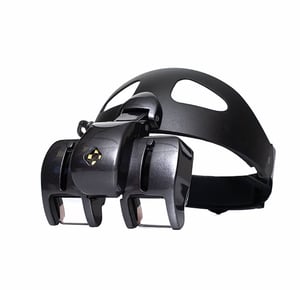 Trivisio offers two AR devices: ARS.31 and LOC.31. The first one is an augmented reality system. It is an optoelectronic device that projects an image or streams video using near-the-eye micro-displays and beam splitter plates. The apparatus has two displays, so three-dimensional content can be visualized using the stereoscopic effect in the user's natural field of view. The HMD is available in two versions, with either an HDMI connector or SMD-7.
Trivisio offers two AR devices: ARS.31 and LOC.31. The first one is an augmented reality system. It is an optoelectronic device that projects an image or streams video using near-the-eye micro-displays and beam splitter plates. The apparatus has two displays, so three-dimensional content can be visualized using the stereoscopic effect in the user's natural field of view. The HMD is available in two versions, with either an HDMI connector or SMD-7.
The second, LOC.31, does basically the same, but with monocular optical see-through HMD. The LOC.31 comes in various mounting options (helmet, headband) or a camera adaptation.
Vivo AR Glass
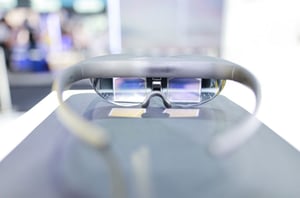 In June 2019, Vivo introduced its strategy to expand its 5G device offerings to include AR glasses. Information about the release date or the pricing hides itself, but the release of Vivo's 5G smartphone is one step closer.
In June 2019, Vivo introduced its strategy to expand its 5G device offerings to include AR glasses. Information about the release date or the pricing hides itself, but the release of Vivo's 5G smartphone is one step closer.
The Vivo AR Glass supports dual-screen display and 6DoF technology. The users can experience a range of applications such as mobile office, AR games, 3D high-definition video, facial recognition, and object recognition when connected to a 5G smartphone. Once the Vivo AR Glass projects the content, the 5G smartphone will then act as the control to switch and select applications.
Univet VisionAR
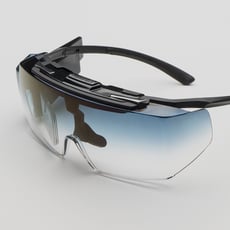 Univet's VisionAR proclaims itself as the first and only augmented reality safety glasses. They have undergone a series of tests, such as the impact test at speeds from 162km/h (101,25 mph) to 684km/h (427,5 mph).
Univet's VisionAR proclaims itself as the first and only augmented reality safety glasses. They have undergone a series of tests, such as the impact test at speeds from 162km/h (101,25 mph) to 684km/h (427,5 mph).
The headset is primarily a platform, rather than a device, designed to be integrated into existing systems or used as stand-alone. It features a transparent display with a monochromatic 8 bit light source and a holographic waveguide. VisionAR is controlled by touch - swiping and tapping.
Vivo AR Glass
 In June 2019, Vivo introduced its strategy to expand its 5G device offerings to include AR glasses. Information about the release date or the pricing hides, but Vivo's 5G smartphone release is one step closer.
In June 2019, Vivo introduced its strategy to expand its 5G device offerings to include AR glasses. Information about the release date or the pricing hides, but Vivo's 5G smartphone release is one step closer.
The Vivo AR Glass supports a dual-screen display and 6DoF technology. The users can experience a range of mobile office applications, AR games, 3D high-definition video, facial recognition, and object recognition when connected to a 5G smartphone. Once the Vivo AR Glass projects the content, the 5G smartphone will then act as the control to switch and select applications.
Vuzix Blade
 Vuzix Blade is built for industrial operations and is designed for all-day comfort. Waveguide optics project real-time content for seamless integration of the digital and the real world.
Vuzix Blade is built for industrial operations and is designed for all-day comfort. Waveguide optics project real-time content for seamless integration of the digital and the real world.
The glasses feature an HD camera, noise-canceling mics, wireless WiFi, UV protection lenses, dual haptic feedback, multilingual voice control, and MicroSD expansion.
The Blade Upgraded Smart Glasses is one of the first all self-contained AR smart glasses available. They benefit from the same features as the regular Blade but also include an auto-focus 8-megapixel camera, built-in stereo speakers, and advanced Vuzix voice control. Prescription inserts are also optionally available.
WaveOptics
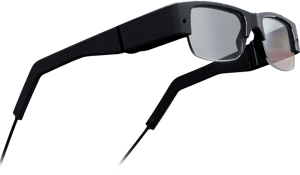 Luxexcel, a company specializing in 3D printed prescription lenses, announced a partnership with waveguides developer WaveOptics to develop a line of AR smart glasses.
Luxexcel, a company specializing in 3D printed prescription lenses, announced a partnership with waveguides developer WaveOptics to develop a line of AR smart glasses.
WaveOptics displays are designed to overcome the three significant challenges for AR wearables - design, cost, and optical performance. The company's waveguides are customizable to meet customers' demands. They can be manufactured at scale while delivering clear, crisp, high-quality AR images.
The companies plan on showing a prototype of their glasses during the SPIE AR, VR, MR conference this March. We can expect samples to arrive in Q2 of 2021.
Qualcomm Smart Viewer
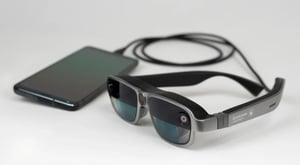 Qualcomm is releasing a reference design for smart glasses to hopefully speed up the development of AR gadgets.
Qualcomm is releasing a reference design for smart glasses to hopefully speed up the development of AR gadgets.
The Qualcomm AR Smart Viewer features dual 0.71-inch microdisplays with a 1920 x 1080 resolution and a 90 Hz refresh rate, along with support for six degrees of motion-tracking, hand-tracking, and dual 1-MP cameras. There's also support for an 8-MP RGB camera, which be used to deliver "See What I See" remote assistant functionality.
Designed as a way to test both desktop and mobile applications, the AR Smart Viewer can be tethered to a smartphone, desktop PC, or computing puck.
The AR Smart Viewer is a reference design. Its primary function is to help developers and engineers test out or design future apps and devices.
The AR Viewer isn't yet displayed on Qualcomm's website, but the company has released a teaser video. Check it out: https://youtu.be/bzQ3zN2E4KI.
MR Glasses
Canon MREAL
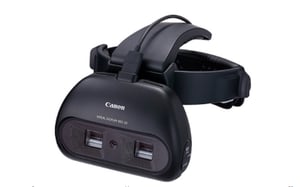 Canon's latest HMD, MREAL DISPLAY MD-20, is lightweight and delivers high image quality. MREAL consists of the HMD, Canon MREAL Platform, base software, and various MREAL display applications.
Canon's latest HMD, MREAL DISPLAY MD-20, is lightweight and delivers high image quality. MREAL consists of the HMD, Canon MREAL Platform, base software, and various MREAL display applications.
It adopts a see-through video system, which creates an MR image by merging real-time pictures of the real world with the virtual 3D CG image. A see-through video system offers many advantages compared to a see-through optical system, including accuracy and realism.
The HMD's camera uses a CMOS sensor employing a global-shutter produced by Canon, making it capable of capturing moving scenery without distortion.
DigiLens
 DigiLens is a waveguide pioneer founded in 2003. The company offers smart solutions of waveguides and heads-up displays, among light engines and development kits.
DigiLens is a waveguide pioneer founded in 2003. The company offers smart solutions of waveguides and heads-up displays, among light engines and development kits.
Their most exciting product line is Visualize framework, which is not actually a product. It's a framework that equips developers with a starter hardware platform to create XR experiences.
The very first glasses built within the Visualizing framework are the v1 glasses. It is optimized to take advantage of the latest technological advances and provides developers with a whole, customizable AOSP/OpenXR-compatible dev system.
JVC
 JVC Kenwood announced late last year that it tested the XR waters with a new headset for enterprise users. The headset was said to boast a wide field of view (FOV) and 2.5k per-eye resolution. At the beginning of this year, the company said the device would be headed to enterprise partners starting in late March.
JVC Kenwood announced late last year that it tested the XR waters with a new headset for enterprise users. The headset was said to boast a wide field of view (FOV) and 2.5k per-eye resolution. At the beginning of this year, the company said the device would be headed to enterprise partners starting in late March.
The project, which has been in development since 2018, mainly targets the simulator market. However, the company also sees it being used in the construction and medical fields.
Not much to add at this point. We'll make an update, if there is one, on the next roundup.
Magic Leap
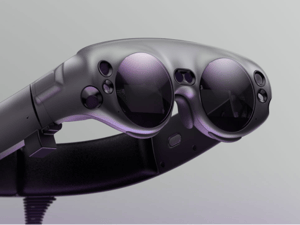 It's not VR; it's not smartphone AR. It's a spatial computer. Magic Leap 1 is a lightweight, wearable computer that brings the physical and digital worlds together.
It's not VR; it's not smartphone AR. It's a spatial computer. Magic Leap 1 is a lightweight, wearable computer that brings the physical and digital worlds together.
Magic Leap 1 scans and understands the world around you, remembers where you last put things, and recognizes and responds to your head position and eye movement. With accurate hand tracking, you can point, shake, fist bump, and even work on your tennis serve.
Microsoft HoloLens 2
 HoloLens 2 is an immersive, ergonomic, instinctual, and untethered MR glasses made by Microsoft. HoloLens 2 offers comfortable and immersive mixed reality experiences, with solutions that deliver value in minutes - all enhanced by the reliability, security, and scalability of the cloud and AI services.
HoloLens 2 is an immersive, ergonomic, instinctual, and untethered MR glasses made by Microsoft. HoloLens 2 offers comfortable and immersive mixed reality experiences, with solutions that deliver value in minutes - all enhanced by the reliability, security, and scalability of the cloud and AI services.
HoloLens 2 is primarily meant for businesses to better their collaborations.
Nreal
Nreal aims to make mixed reality available and accessible to everyone. The China-based company has been actively developing user-friendly mixed reality wearables since 2017.
Nreal Light is a pair of mixed reality glasses sporting a wide-screen, vivid display. Nreal strives to bring mixed reality a step closer to reality by offering a full spatial computing capability and cross-platform compatibility. Nreal has also launched an app, Nebula, to turn the user's favorite mobile apps into immersive experiences.
Nreal MR glasses launched in Japan and South Korea in 2020 and are planned to ship in Europe sometime in 2021.
The company has also added a dev kit to its selection. The dev kit comes with 6DoF space recognition, plane detection, hand tracking, multiplayer mode and is compatible with all Android apps.
Rokid
Rokid specializes in the research and product development of mixed reality and artificial intelligence. With its mission of "leave nobody behind," Rokid provides enterprise solutions for developing communities. Rokid was established in 2014 and is based in California, US.
Rokid offers two pairs of glasses: Rokid Vision for mobile usage and Rokid Glass 2, designed for multiple use scenarios. Roughly said, Rokid Vision is for consumer-like usage when Rokid Glass 2 is aimed at enterprises. The company has also released Rokid X-Craft, an explosion-proof AR headband equipped with a 5G module. It is equipped with an AI algorithm and AR technology, enabling workers to update information automatically and increase work efficiency.
Shadow Creator
A Chinese company Shadow Creator, founded in Shanghai, China, in 2014, specializes in mixed reality, artificial intelligence and semiconductor, and the development of applied technologies and products. Since our last roundup, the company has launched two more MR glasses: JIMO glasses and Halo Mini smart glasses. In addition to these, the company has released an MR system, Honghu. The system includes glasses, Qualcomm Snapdragon XR2, full freedom of gesture operation, 3D spatial stereo sound, 52° field of view, 85g lightweight design, and holographic space positioning.
 The Action One glasses promise to give natural interaction between reality, virtuality, and users. The user controls the glasses either with a controller, gestures, or voice command. Halo Mini smart glasses use OLED chips of high brightness, optical resin aspheric eyepieces (high definition, low distortion, big field of vision), and polycarbonate beam splitter lenses (high strength). The JIMO glasses have the most user-friendly-looking design and very similar features to the Action One glasses.
The Action One glasses promise to give natural interaction between reality, virtuality, and users. The user controls the glasses either with a controller, gestures, or voice command. Halo Mini smart glasses use OLED chips of high brightness, optical resin aspheric eyepieces (high definition, low distortion, big field of vision), and polycarbonate beam splitter lenses (high strength). The JIMO glasses have the most user-friendly-looking design and very similar features to the Action One glasses.
ThirdEye X2
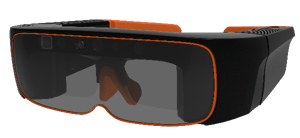 ThirdEye X2 offers enterprise organizations a complete MR solution out of the box. Frontline workers can view schematics, diagrams, and instructions while improving first-time fix rates, decreasing error rates, and doing more quality jobs in a day.
ThirdEye X2 offers enterprise organizations a complete MR solution out of the box. Frontline workers can view schematics, diagrams, and instructions while improving first-time fix rates, decreasing error rates, and doing more quality jobs in a day.
Designed for enterprise use, the X2 comes with environment tracking, wide field of view, noise-canceling microphones, and a high-resolution camera, to name a few features. The X2 MR glasses run on the open-source Android OS.
ThirdEye also offers a developer kit, consisting of a pair of X2 MR Glasses, a VisionEye SLAM Module, and free software developer support.
Varjo XR-3
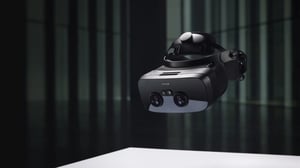 Varjo XR-3 delivers the most immersive mixed reality experience ever constructed, featuring photorealistic visual fidelity across the broadest field of view of any XR headset. Varjo XR-3 depth awareness combines LiDAR sensor and stereo RGB video feed.
Varjo XR-3 delivers the most immersive mixed reality experience ever constructed, featuring photorealistic visual fidelity across the broadest field of view of any XR headset. Varjo XR-3 depth awareness combines LiDAR sensor and stereo RGB video feed.
Varjo XR-3 is designed with a 3-point precision fit headband to enable maximum comfort, even during longer immersive sessions. Automatic IPD, active cooling, 90 Hz frame rate, and non-Fresnel lenses allow working without eye strain or simulator sickness. Varjo XR-3 can be used comfortably with glasses.
Smart glasses
Amazon Echo Frames
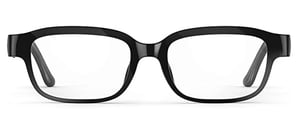 After an introductory period, the Amazon Echo Frames built an improved Echo Frames gen. 2.
After an introductory period, the Amazon Echo Frames built an improved Echo Frames gen. 2.
With the Amazon Echo Frames, you can make calls, set reminders, add to your to-do lists, listen to podcasts, or control your smart home from anywhere. They also support Google Assistant and Siri. Echo Frames are designed for every-day-use; they are lightweight and compatible with most prescription lenses. Built-in microphones respond to the voice of the person wearing the frames, so your privacy is safe.
Echo Frames require a compatible Android or iOS smartphone and the Alexa app for connectivity and use the user's existing smartphone data plan.
Bosch BML500P
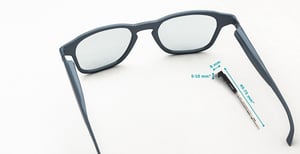 The Bosch Smartglasses Light Drive provides a complete, ready-to-use solution for smaller, lighter, more stylish smart glasses. The glasses are compatible with curved and corrective lenses.
The Bosch Smartglasses Light Drive provides a complete, ready-to-use solution for smaller, lighter, more stylish smart glasses. The glasses are compatible with curved and corrective lenses.
The BML headset features hands-free information in a minimalist format. Information such as navigation, calls, notifications, alarms, and calendar reminders are presented in privacy. Also, messaging platforms such as WhatsApp and WeChat are available.
The glasses, weighing less than 10 grams, offer a 15-degree Field of View, a 60 Hz frame rate, and a 14-hour operating time.
"The Bosch Smartglasses Light Drive module is a sole source, all-in-one technology stack consisting of MEMS mirrors, optical elements, sensors, and onboard processing. This integrated solution delivers a clean visual experience with bright images, always in focus – even in direct sunlight."
Epson MOVERIO BT
 Epson's Moverio BT series offers eyewear to smart working and setting a new standard for AR.
Epson's Moverio BT series offers eyewear to smart working and setting a new standard for AR.
The series includes various models, from enabling manufacturers to utilize hardware better and bringing destinations to life to second-screen smart glasses and two pro models for critical industries and demanding environments.
 Facebook Inc.'s planned smart glasses will arrive sometime in 2021. However, they won't feature digital overlay technology that is associated with augmented reality. The glasses, which are being built in partnership with Ray-Ban, will connect to a device.
Facebook Inc.'s planned smart glasses will arrive sometime in 2021. However, they won't feature digital overlay technology that is associated with augmented reality. The glasses, which are being built in partnership with Ray-Ban, will connect to a device.
Much like Apple's AR glasses, there isn't much information about Facebook's glasses. Still, they are part of the company's long-term effort to capture the next big computing platform after the smartphone. They align with Facebook's philosophy around AR, which is to make technology peripheral to human interactions to enhance "presence."
A common situation Facebook has cited is parents trying to record memories with their young children: "By the time you get the phone up, not only have you probably missed it, but if you don't miss it, you're probably watching the real event but through your phone. If you have the right technology, it can get out of the way."
We'll keep an eye on Facebook and give an update on our next roundup.
Form Swim Goggles
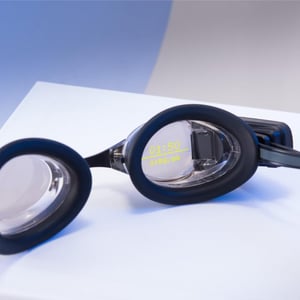 Swim with accurate real-time performance metrics. Built for pool, open water, and swim spa swimming. Connect compatible smartwatches and heart rate monitors. This is how Form Swim Goggles introduce themselves on their website.
Swim with accurate real-time performance metrics. Built for pool, open water, and swim spa swimming. Connect compatible smartwatches and heart rate monitors. This is how Form Swim Goggles introduce themselves on their website.
The goggles include an outdoor-readable see-through display, are waterproof up to 10 meters or 32 feet, have a battery life of 16 hours and connect via Bluetooth. They measure various metrics, such as split time, stroke rate, calories burned, and heart rate.
Form also features its own app and can be connected to a GPS watch or used on its own.
Iristick
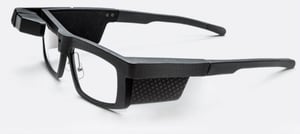 These industrial smart glasses enable hands-free remote assistance, step-by-step workflow guidance, and pick-by-vision. The Iristick glasses come in three models: Premium, Essential, and Basic.
These industrial smart glasses enable hands-free remote assistance, step-by-step workflow guidance, and pick-by-vision. The Iristick glasses come in three models: Premium, Essential, and Basic.
These industry-targeted smart safety glasses give unrestricted field of view, zoom in to small details, and make sure no radiation near your temple. They also feel and look like a standard pair of glasses!
Lenovo ThinkReality
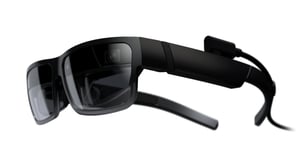 ThinkReality A3 is part of a comprehensive digital solution offering intelligent transformation in business and bringing smarter technology to more people. It aims to enhance productivity for office professionals and industrial workers.
ThinkReality A3 is part of a comprehensive digital solution offering intelligent transformation in business and bringing smarter technology to more people. It aims to enhance productivity for office professionals and industrial workers.
These AR smart glasses are powered by the Qualcomm Snapdragon XR1 Platform for high-quality performance and feature stereoscopic 1080p displays presenting the user with up to 5 virtual displays. An 8MP RGB camera provides 1080p video for remote expert use cases, while the dual fish-eye cameras provide room-scale tracking.
ThinkReality A3 tethers to a PC, bringing immersive capabilities to everyday work with customized virtual monitors and 3D visualization to immersive training.
Level
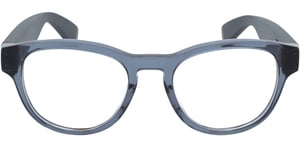 Level has decided to wind down its program, focusing on future smart glasses programs and partnerships through the company's Global Innovation Center.
Level has decided to wind down its program, focusing on future smart glasses programs and partnerships through the company's Global Innovation Center.
Level smart glasses integrated activity-tracking technology into an accessory you already wear every day.
The Level glasses worked together with the Level app. With the app, you could easily track your activity, build momentum towards your goals, and - the one feature all of us four-eyes long for - find your glasses!
The glasses were available in three frames.
Lowdown Focus
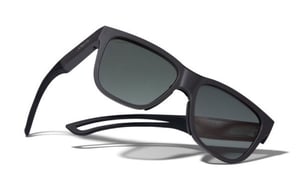 The Lowdown Focus looks to have disappeared on the Smith's online store since our last roundup.
The Lowdown Focus looks to have disappeared on the Smith's online store since our last roundup.
Smith's Lowdown Focus glasses measured the user's brain activity while training cognitive skills and living life.
Used together with Smith Focus App, the eyewear recorded and visualized the user's activity and progress. The combination then offered a program for improved performance. It ultimately aided in targeting the user's goals and objectives for excelling in a sport or combating daily stressors.
Lucyd
 With Lucyd Lyte frames, you can listen to music and change tracks, make and answer calls and use Siri, Google Assistant, or Alexa.
With Lucyd Lyte frames, you can listen to music and change tracks, make and answer calls and use Siri, Google Assistant, or Alexa.
The new generation of smart eyewear from Lucyd offers a unique mix of designer styling, vision correction, protection, and smart features. The Bluetooth frames help call answering, play/pause, track skip, volume adjustment, and voice assistant activation.
MAD Gaze
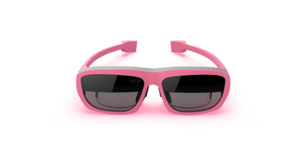 MAD Gaze offers it all - smart glasses for both consumers and enterprises, a store to download apps for the headset, and a developer platform.
MAD Gaze offers it all - smart glasses for both consumers and enterprises, a store to download apps for the headset, and a developer platform.
The consumer glasses feature smart solutions for sports, calls, 3D movies, gaming, working&editing, navigation, translation, messaging, and live streaming. The enterprise solutions include banking&finance, logistics, security, stem education, retail, and medical. These use cases come via the apps.
The company offers five sets of smart glasses: Ares, X5, Vader, Glow, and Glow Plus. Ares is said to be multi-functional smart glasses, X5 a fun and trendy must-have gadget, Vader blending seamlessly the virtual with the real, Glow offering magnificent convergence of reality and imagination, and Glow Plus doing the same.
Prices go from 249€ (Ares) to 559€ (Glow Plus).
Mojo Vision
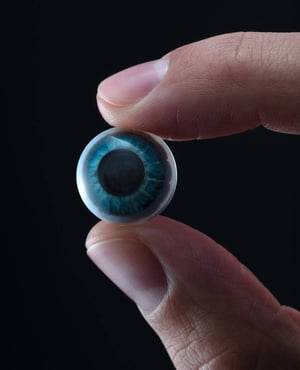 Mojo Vision introduces the world's only contact lens that elevates vision.
Mojo Vision introduces the world's only contact lens that elevates vision.
Mojo Lens is a smart contact lens with a built-in display. By understanding the real-world context, Mojo Lens provides relevant, eyes-up notifications and answers. Mojo Lens is designed by optometrists, technologists, and medical experts.
Mojo Vision states that today's AR headsets are too awkward to be worn in social and professional situations, and many AR solutions try to create immersive experiences that can clutter reality. That's why Mojo has pioneered Invisible Computing's concept—a display that never gets in the way.
Norm Glasses
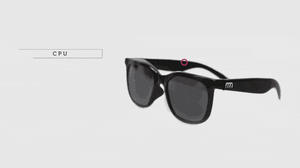 "Designed for everyday use, Norm brings you the next generation of wearable technology. Sleek, stylish, and comfortable eyewear fully loaded with patented features that will make you forget that you are wearing glasses with a powerful built-in microcomputer!"
"Designed for everyday use, Norm brings you the next generation of wearable technology. Sleek, stylish, and comfortable eyewear fully loaded with patented features that will make you forget that you are wearing glasses with a powerful built-in microcomputer!"
Norm Glasses offer turn-by-turn navigation, capturing photos and video, receiving and making calls and text messages, and listening and watching instructions. They come with an HD camera, visual navigation, voice commands, open-ear sound and are lightweight.
The lenses come with different options: tinted, transition, polarized, and clear, all with or without a prescription. Their battery life is 4-day standby with 2-hour charging time.
Optivent ORA-2
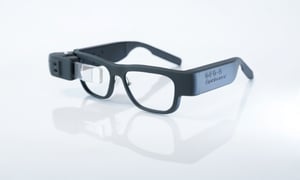 The ORA-2 is a rugged wearable computing device- it is a smart glass platform for mobile AR and wearable computing. The ORA-2 enables hands-free mobile computing and AR applications such as remote maintenance, logistics, remote training, and situation awareness. It can run applications as a stand-alone wearable computer and WiFi and Bluetooth to networks and smart devices.
The ORA-2 is a rugged wearable computing device- it is a smart glass platform for mobile AR and wearable computing. The ORA-2 enables hands-free mobile computing and AR applications such as remote maintenance, logistics, remote training, and situation awareness. It can run applications as a stand-alone wearable computer and WiFi and Bluetooth to networks and smart devices.
The ORA-2 is equipped with a dual-core processor, camera, microphone, sound, inertial sensors, WiFi, Bluetooth, GPS, ambient light sensor, and a high capacity rechargeable battery.
Solos
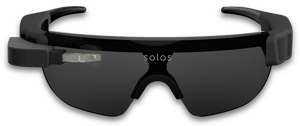 Solos is a combination of sensors, analytics, and high-performance smart glasses that will make your activities faster, easier and more fun. Solos smart glasses merge your preferred performance data and put it all right in front of you to entirely focus on your training.
Solos is a combination of sensors, analytics, and high-performance smart glasses that will make your activities faster, easier and more fun. Solos smart glasses merge your preferred performance data and put it all right in front of you to entirely focus on your training.
With the combination of the Solos app and the smart glasses, you can hit your performance thresholds, find your next turn, see who's calling, or get your latest social feed update.
TCL Wearable Display
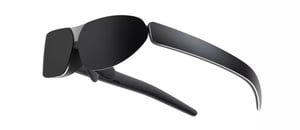 TCL Wearable Display is a pair of glasses with two 1080p mini OLED screens on the inside. This is rather a new take on wearable, personal display that gives the viewer the effect of looking at a large screen than an XR headset.
TCL Wearable Display is a pair of glasses with two 1080p mini OLED screens on the inside. This is rather a new take on wearable, personal display that gives the viewer the effect of looking at a large screen than an XR headset.
The glasses connect to a device with USB-C. The upcoming glasses produce the effect of viewing a 140-inch display from four meters away, with a density of 49 pixels per degree. They're also capable of displaying 3D content.
The company hasn't given a price for the glasses yet. It says the wearable will be available later this year in select markets.
Vue
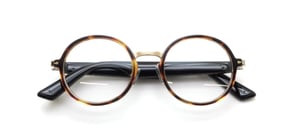 Vue comes in two models: Pro/Original and Lite.
Vue comes in two models: Pro/Original and Lite.
Track steps, listen to music, make phone calls, and more—all with Vue's unisex smart glasses. Vue features audio technology, touch control, voice assistant, and Find My Glasses! Vue also has an app to make the usage smooth and efficient.
Vue's bone conduction audio technology transfers stereo sound to your inner ear. Your ears remain unplugged, so you can listen to music, answer calls, and hear notifications while still hearing the world around you.
Vue Lite comes with fewer features but functions without the app.
Vuzix
 Vuzix's M-Series provides a variety of comfortable all-day wearable options for enterprise workers. The glasses come in two forms: the two kinds of starter kits and the M4000 smart glasses.
Vuzix's M-Series provides a variety of comfortable all-day wearable options for enterprise workers. The glasses come in two forms: the two kinds of starter kits and the M4000 smart glasses.
The starter kits feature a touchpad, voice and button navigations, WiFi, Bluetooth and GPS, OLED displays, flashlight, and camera. The M4000 features, among the previous, head tracking, see-through Waveguide optics, integrated speaker, and noise-canceling microphones.
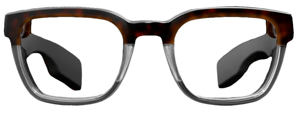 Next Generation brings the perfect combination of style and function. The fully wireless connectivity is made even more dynamic. The glasses can be used indoors or outside with completely see-through advanced waveguide optics and revolutionary micro-LED display engines.
Next Generation brings the perfect combination of style and function. The fully wireless connectivity is made even more dynamic. The glasses can be used indoors or outside with completely see-through advanced waveguide optics and revolutionary micro-LED display engines.
Vuzix states the smart glasses are coming in 2021.
Glasses - availability
AR glasses
| AntVR MIX | Launched on Kickstarter, went silent |
| Apple | Maybe coming |
| CREAL | Evaluation kits available, optical engine planned for 2022 |
| Dream Glass 4K | Available for all |
| EyeWay Vision | Coming |
| Garmin Varia Vision | Available for all |
| Google Glass Enterprise Edition 2 | Enterprise |
| Everysight Raptor | Available for all |
| Kura | Reservable for all |
| Leap Motion | Available for developers |
| LetinAR PinMR | On-demand, lens samples coming in 2020 |
| Lynx | Available for pre-order |
| Meta 2 | Development |
| Mira Prism | Enterprise |
| Niantic | Maybe coming |
| North Focals | Not available / acquired by Google |
| Oppo AR Glass | Maybe coming soon |
| Snap Spectacles | Available for all |
| STMicroelectronics | Coming soon for enterprises |
| Toshiba dynaEdge AR100 Viewer | Development |
| Trivisio | Enterprise |
| Univet VisionAR | Development, enterprise |
| Vivo AR Glass | On its way |
| Vuzix Blade | Available for all |
| VaweOptics | For eyewear manufacturers |
| Qualcomm Smart Viewer | Reference design released |
MR glasses
| Canon Mreal | Enterprise |
| Digilens | Development |
| JVC | Coming soon for enterprises |
| Magic Leap | Development, enterprise |
| Microsoft Hololens 2 | Available for all |
| Nreal Light | Development, pre-orders available |
| Rokid | Available for all |
| Shadow Creator: Action One | Available |
| ThirdEye X2 | Enterprise |
| Varjo XR-3 | On-demand |
Smart glasses
| Amazon Echo Frames | Available for all |
| Bosch BML500P | Available |
| Epson MOVERIO BT-300 | Available for all |
| Maybe coming | |
| Form Swim Goggles | Available for all |
| Iristick | Available for all |
| Lenovo ThinkReality | Coming soon |
| Level | Available for all |
| Lowdown Focus | Available for all |
| Lucyd | Available for all |
| MAD Gaze | Available in select countries |
| Mojo Vision | On-demand for enterprise |
| Norm Glasses | Available for pre-order |
| Optivent ORA-2 | Available for all, designed for enterprise |
| Solos | For ambassadors, retailers, developers |
| TCL Wearable Display | Coming this year to select markets |
| Vue | Available for all |
| Vuzix M-Series | Enterprise |
| Vuzix Next Generation | Coming in 2021 |
If you know of AR/MR/smart glasses not presented here, please let us know, and we'll add them to the group!




